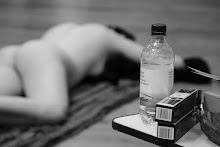A line has no character by itself. Draw one line on a piece of paper. Is it short? Or long? You cannot say until you put another line of a different length beside it. Similarily, a line can seem curved in comparison with one line and straight in comparison with another.
 As a matter of pure exercise, draw a straight line to represent some contour on one side of the model. Then, attached to that, make a curved line. Continue up or down that side of the figure, alternating straight and curved lines and attaching each line to the one before it and the one after it. Proceed in the same way all the way around the figure but wherever there is a straight line opposite, try and put a curve on the other side. These should be done in five minute studies. They will probably look like charts.
As a matter of pure exercise, draw a straight line to represent some contour on one side of the model. Then, attached to that, make a curved line. Continue up or down that side of the figure, alternating straight and curved lines and attaching each line to the one before it and the one after it. Proceed in the same way all the way around the figure but wherever there is a straight line opposite, try and put a curve on the other side. These should be done in five minute studies. They will probably look like charts.As a natural result of practicing this exercise, you will begin to search the model in order to discover which contours may be best expressed by straight lines and which by curved lines. Now, you do not have to follow the straight with the curve, you will use each when it seems most suitable.
Reach in your drawing for movements that are biggest, simplest and most connected, thinking of them as either straight or curved; that goes through the entire figure.




